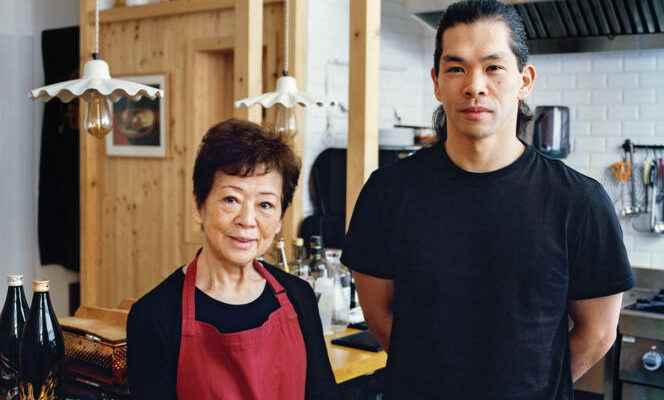Go Sato is the son of Atsuko Sakamoto. Together, they always dreamed of opening their own izakaya, inspired by these places of Japanese mouth, in which city dwellers traditionally come to relax after a long day of work. As in the small restaurant that Atsuko ran when she was young, in Tokyo, we would drink beer, whiskey-based cocktails or Japanese spirits: sake, shōchū, umeshu… perk up there around a selection of hot or cold dishes.
A little less than a year ago, they finally found the place: a small discreet sign away from the hubbub, in a street in the Opéra district, in Paris. There, around an “L” shaped bar and a large open kitchen, they have rebuilt a part of their universe: Zakuro. Go hung a Japan baseball jersey and a motorcycle racing poster, his great passion, on the wall.
On a shelf, Atsuko has set up some of her beautiful floral ceramic bowls, which she paints by hand. “We were keen to make this cuisine that we have always eaten at homeexplains Go. These comforting dishes that accompanied my mother all her life – and rocked my childhood. 90% of the revenue comes from her own repertoire. I add my little touch new school and my Western influences for the remaining 10%. »
A kitchen that flows from source
The products are carefully selected and the menu evolves according to arrivals and inspirations. At the moment, there is kakuni, a marvel of braised pork belly – simmered for a long time and served meltingly in its reduction juice. There’s also a delicious tuna karaage: the pieces of fish have been marinated in soy sauce, garlic and ginger, before being delicately fried in breadcrumbs, a la minute.
And as it’s still a little cold outside, Go and Atsuko have prepared oden, this invigorating Japanese dish made here from a base of dashi broth, decorated with small fish patties, a hard-boiled egg and daikon. Some dishes, which are not on the menu, appear ephemerally and spontaneously in full service, like a surprise.
She watches over the fire, prepares the plates and takes her time. He has an athletic build and an easy dialogue. He sets the pace, takes care of the bar and puts customers at ease.
The cuisine of Go Sato and Atsuko Sakamoto resembles them: it flows naturally, like a filial bond. It shows a piece of culture, of common memories. She tells something about these recipes that a mother has at heart to pass on to her son – so that he can appropriate them and distill them in turn.
You have to see them both evolve in the kitchen, during the service. Atsuko has a soft look and an elegant gesture. She watches over the fire, prepares the plates and takes her time. Go has an athletic build and easy dialogue. He sets the pace, takes care of the bar and puts customers at ease. Sometimes mother and son will gently bicker over cooking or seasoning. We ask Atsuko what makes her so happy to cook, despite advancing age: “It’s a way of leaving a trace of my passage on this earth. »
Zakuro, 4, rue de Port-Mahon, Paris 2e. Open Tuesday to Saturday, from 7 p.m.
